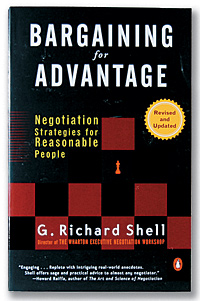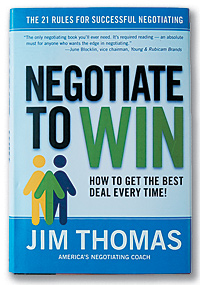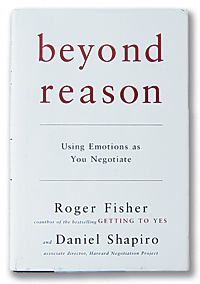Best Business Books: Negotiation
Art, Science, and Wisdom, or the Logic of Leverage
(originally published by Booz & Company) G. Richard Shell,
G. Richard Shell,
Bargaining for Advantage: Negotiation Strategies for Reasonable People
(Penguin, 2nd edition, 2006)
Jim Thomas,
Negotiate to Win: The 21 Rules for Successful Negotiating
(Collins, 2005)
Roger Fisher and Daniel Shapiro,
Beyond Reason: Using Emotions as You Negotiate
(Viking, 2005)
In 1689, the English House of Lords was debating what title to give Prince William of Orange, who had recently chased James II out of the country. Should he become king, regent, or prince consort? Prince William summoned a group of prominent lords to his apartments with this offer: Crown him king, or he and his army would go back to the Netherlands, James would return, and the lords’ heads would be in severe danger. Bingo! Within two days, the House of Lords decided that king was the right job title.
Such stories have a peculiar fascination. There seems to be a kind of innate logic at play, an awareness of the “golden moment,” when one side’s leverage is heightened. In more mundane terms, if you are negotiating a job, you are well positioned to negotiate the terms (including the job title) after the offer has been made (in William’s case, after James had fled), but before you accept it (before a new constitutional settlement had been worked out). If only we could master that logic, we would maximize our chances of coming out on top in all the negotiations we undertake — in business, politics, private life. Hence the stream of negotiation books, which package that logic in different styles — reflective, analytical, or wisecracking.
Among these books, few have rivaled Getting to Yes: Negotiating Agreement without Giving In (Houghton Mifflin), the 1981 book written by Roger Fisher and William Ury. The original edition of Getting to Yes was developed at Harvard University’s Negotiation Project, which introduced an approach that focuses on mutual interests and fairness, not on maintaining positions and winning the contest of will. That approach has been credited with helping political leaders resolve difficult conflicts around the world. (In the spirit of disclosure, I should add that in 1975 I designed and helped Roger Fisher teach the Harvard course that preceded the book.)
In the last year, however, a trio of books have been published that are worthy of attention even alongside Getting to Yes. One displays the word reasonable on its cover, one has win, and the third features emotion. Readers may take their pick.
To distinguish these books, it is helpful to recognize that every negotiation involves three fundamental elements: art, science, and wisdom. Artistry is always involved, because negotiations can never be fully planned; the circumstances vary too much. At the heart of even the most mutually beneficial negotiation, there is always a haggle between two conflicting positions. A creative solution can clear a stalemate and produce agreement, but not by eliminating or resolving the conflict; rather, by suggesting new, acceptable concessions that make the conflict less intense. Making this happen is the art of negotiation.
The second element is science. Why would one person ever concede anything to another? Because the first person judges that without that concession, the second person will walk away from the deal. The leverage held by each of them can be determined analytically: It can be expressed as the difference between the expected cost of the concessions and the cost of a failure to reach agreement. The science of negotiation is the process of maximizing leverage — what strategists call advantage — by analyzing this difference in cost (which is subject to change at any moment).
The third fundamental element is wisdom. Every negotiation entails some wisdom. Otherwise, we would just have open conflict. Wisdom is the ability to observe the negotiation as it evolves, so that one can seize the opportune moment just as Prince William did. Wisdom also involves the ability to anticipate the negotiation’s most likely results after the deal is struck. A skilled and ruthless negotiator may win every last demand, but never again be invited to the table. A cultivated sense of timing helps any negotiator reach his or her most important goals: to win the most critical concessions, or possibly to negotiate a change in the rules that will provide winnings forever without any more negotiations being necessary.
 Art, science, and wisdom are covered in all three books, but each treats them differently. In Bargaining for Advantage: Negotiation Strategies for Reasonable People, G. Richard Shell translates his understanding of these elements into tactical advice. Professor Shell runs the Wharton Executive Negotiation Workshop, and his book is a comprehensive manual, including theory, examples, and practical tips. (This new version of a 1999 edition is so thoroughly revised that it is worth including among the best books of this year.)
Art, science, and wisdom are covered in all three books, but each treats them differently. In Bargaining for Advantage: Negotiation Strategies for Reasonable People, G. Richard Shell translates his understanding of these elements into tactical advice. Professor Shell runs the Wharton Executive Negotiation Workshop, and his book is a comprehensive manual, including theory, examples, and practical tips. (This new version of a 1999 edition is so thoroughly revised that it is worth including among the best books of this year.)
Bargaining for Advantage points out that different individuals have different negotiating styles (and includes a self-assessment tool for helping readers determine their style). Different styles suit different situations: The collaborative, problem-solving negotiator is well suited to complex negotiations in which the ongoing relationship matters; the competitive negotiator to simpler, zero-sum negotiations. We cannot always choose the type of negotiation we enter into, but we can choose the negotiator who represents us, or the persona we take on when we negotiate for ourselves. Here is where artistry comes in: A skillful, self-aware assessment of oneself and one’s representatives is the first step of a successful negotiation. The recognition that not everyone needs the same lessons marks Professor Shell as a sophisticated educator.
He also showcases wisdom, particularly in his tales of great negotiators. For example, in 1955 Akio Morita came to the United States to sell Sony’s new transistor radios and establish the company’s brand name in the U.S. market. There was very little interest until Bulova offered to buy 100,000 units, a deal that would have been hugely profitable for Sony. Unfortunately, Bulova insisted that the radios be marketed under the Bulova brand name. Mr. Morita agonized and cabled his board for instructions. They did not hesitate and told him to accept the deal. However, he did not follow their instructions, rejected the deal, and somewhat later secured a less lucrative distribution arrangement that allowed Sony to use its own brand name.
The negotiation had crystallized Mr. Morita’s awareness of his true goal, given his company’s purpose: to establish the Sony brand. This knowledge helped him take the risk of turning down Bulova. And that, in turn, was critical to Sony’s ultimate success in global consumer electronics. One reason it’s so important to understand the long-term purpose and intermediate goals of a negotiating position is that this information reduces risk aversion. Risk-averse people are more likely to take the other party’s signals at face value and thereby become easy to manipulate.
Perhaps Professor Shell’s most distinctive contribution is his discussion of science, particularly the way negotiators use norms to secure their objectives. This happens, for example, when one side encourages the other to make concessions to appear consistent with their professed ideals: “You speak eloquently in favor of transparent governance, which is fortunate because we need you to make your financial records available.” Another interesting example is the use of what Professor Shell calls “positioning themes”: the invocation of a norm or expectation that would be costly to break. In 1997, the International Brotherhood of Teamsters union defeated UPS’s policy of restricting workers to part-time schedules. This victory came about at least partly because the union developed and exploited a positioning theme — “part-time America won’t work” — which rallied the workers and which the company could not be seen to fight.
 G. Richard Shell, as he acknowledges himself, is a “collaborative” negotiator, and at times he seems sanguine about the inevitable triumph of reason. Jim Thomas, author of Negotiate to Win: The 21 Rules for Successful Negotiating, has (as his book’s title suggests) a more competitive style. Brash and direct, he opens the book by telling the reader, “It’s not your imagination: Things really are getting tougher.” In a world of shrinking margins, formerly fat and happy Westerners will have to learn to pursue ruthless, frugal, competitive deals in the global bazaar, whether they like it or not, just to remain alive. He dismisses negotiators who aim to discover the true needs and interests of the other party. As he imagines it:
G. Richard Shell, as he acknowledges himself, is a “collaborative” negotiator, and at times he seems sanguine about the inevitable triumph of reason. Jim Thomas, author of Negotiate to Win: The 21 Rules for Successful Negotiating, has (as his book’s title suggests) a more competitive style. Brash and direct, he opens the book by telling the reader, “It’s not your imagination: Things really are getting tougher.” In a world of shrinking margins, formerly fat and happy Westerners will have to learn to pursue ruthless, frugal, competitive deals in the global bazaar, whether they like it or not, just to remain alive. He dismisses negotiators who aim to discover the true needs and interests of the other party. As he imagines it:
BUYER: “I want a 10% price rollback. Now.”
SELLER: “I hear what you are saying…but what are we really talking about? Is this a recognition thing for you? An empowerment thing? Do you feel my company has not treated you with enough respect in the past? Let’s be honest with each other.”
BUYER: “Thanks, pal, but if I’d wanted psychotherapy, I woulda’ called a shrink. I’m here to talk pricing. And I’m in a hurry. What’s it going to be?”
Mr. Thomas’s book is thus primarily about tactics in the core “science” process of negotiation: getting the other side to make concessions in a zero-sum game. He is somewhat skeptical about the “creative” side: It is important, he admits, but the returns should not be exaggerated. While Professor Shell’s book suffers from excessive complexity — it is chock-full of frameworks and structures, with four steps, four types of negotiation, five styles, six foundations, and no single organizing principle — Mr. Thomas’s book is refreshingly straightforward. He offers seven critical rules, four important but obvious rules, 10 “nice to do” rules, and a bit about ethics and special situations. To its credit, the book always explains the logic of its advice. It is not especially original, but it is punchy, no-nonsense, and humane.
Although Mr. Thomas has a more competitive style than Professor Shell, he places just as much emphasis on the importance on relationships and is actually tougher on ethics, stating categorically that negotiators should never lie. As for wisdom, he admonishes the reader not to “hose” the other side — not to use every bit of leverage and every tactic in the book to get the best possible deal. Given widely prevalent norms of fair play, such “win-lose” deals really pay off only when there will be no subsequent relationship. Instead, the Thomas-guided negotiator seeks a win-win deal, meaning that both parties feel they have achieved their objectives even if they have not maximized their gain.
Ironically, this discussion of purpose is the one place where the hard-edged and ruthless Mr. Thomas turns out to be a bit too benevolent. Major retail chains, for example, bargain very hard with their suppliers — Wal-Mart under Sam Walton was known as “the rudest account in America.” This did not stop the vendors from supplying the company, and it did not stop Wal-Mart from becoming the biggest retailer in the world. Of course you have to keep the other side alive if you want to work with them again — but only just long enough to fulfill your objectives.
In reality, as I have found in my 20-year career as a professional negotiator, it is more useful to stay focused on balancing short- and long-term outcomes. Optimizing the latter may require modification to the negotiating strategy. This does not necessarily mean being soft — indeed, one of the classic justifications for adopting a tough negotiating stance is the need to manage future expectations. A vivid example is negotiations with terrorists, which might involve short-term concessions, but only if they are not seen as leading to long-term loss of control over the situation. A more everyday case is traditional employment negotiations, in which an unequal power relationship established at the outset may prove very useful later to the party that starts with the upper hand — this is usually, although not always, the employer. This may not sound very nice, but it is reality. The fact is that there are many negotiated injustices in the world, and good (efficient) negotiation is not always good (moral) negotiation.
 One of Mr. Thomas’s important but obvious rules is “keep the climate positive,” and much of Roger Fisher and Daniel Shapiro’s Beyond Reason: Using Emotions as You Negotiate focuses precisely on how to do this. The authors make plain that negotiation is not just a matter of logic, but of emotion, too. The book is a sequel to Getting to Yes, but it also represents a significant change in Professor Fisher’s thinking. For most of his career, he has been on record as saying that the single critical factor in the ability of a negotiator is clear thinking and logical capability. Personally, I have long disagreed with this; when analytically trained people overlook the emotional resonance of their negotiations, they can damage their own and everybody else’s interests. But his coauthor, Dan Shapiro, is a trained clinical psychiatrist. If he could persuade Roger Fisher of the value of emotion in getting to “yes” (and apparently it took a number of years), then he should be persuasive enough for anyone!
One of Mr. Thomas’s important but obvious rules is “keep the climate positive,” and much of Roger Fisher and Daniel Shapiro’s Beyond Reason: Using Emotions as You Negotiate focuses precisely on how to do this. The authors make plain that negotiation is not just a matter of logic, but of emotion, too. The book is a sequel to Getting to Yes, but it also represents a significant change in Professor Fisher’s thinking. For most of his career, he has been on record as saying that the single critical factor in the ability of a negotiator is clear thinking and logical capability. Personally, I have long disagreed with this; when analytically trained people overlook the emotional resonance of their negotiations, they can damage their own and everybody else’s interests. But his coauthor, Dan Shapiro, is a trained clinical psychiatrist. If he could persuade Roger Fisher of the value of emotion in getting to “yes” (and apparently it took a number of years), then he should be persuasive enough for anyone!
The book thus makes a good case that successful negotiators do not suppress feeling. They “read” it, in themselves and their counterparties, and this then becomes the source of their wisdom: It helps them understand what is going on. Emotional skill is also directly related to the art of negotiation: the ability to express emotion in a way that encourages others to recognize and express their own feelings, and thus influence what is going on more effectively. There is also a link to science. Good negotiators do not try to manage emotions directly, because emotions are too complex and fluid. Instead, negotiators dispassionately analyze the “core concerns” that have given rise to the flood of feeling that is already in the room when an important negotiation takes place.
The authors identify five concerns that affect a negotiator’s emotions: appreciation (being valued), affiliation (being welcomed in the group), autonomy (being trusted to make independent judgments and act accordingly), status (being recognized), and role (having the authority to change the mission). When these concerns are satisfied, then people feel positive. When they are not, people tend to feel negative. It is easier to negotiate with someone who feels positive than with someone who feels negative — and when feeling positive rather than negative oneself. Accordingly, the bulk of the book is about how to help others (and yourself) satisfy these concerns.
A negotiator does not have to expect a long-term relationship with his or her counterparty to benefit from predominantly positive feelings on both sides of the table. For example, optimism helps generate the kind of problem-solving approach that can unblock an impasse. Anger on the other side can reduce your leverage, encouraging the other side to walk when a coolly rational perspective would keep them in the room. Above all, positive emotions help build trusting relationships, which, whether or not they last beyond the negotiations themselves, help the parties think creatively and make less risky concessions.
The authors cite President Jimmy Carter’s Camp David talks with Menachem Begin and Anwar Sadat in the 1970s:
Begin had asked for autographed pictures of Carter, Sadat and himself to give to his grandchildren. Carter personalized each picture with the name of a Begin grandchild. During the stalemate in talks, Carter handed Begin the photographs.… [Begin’s] lips trembled.… He and Carter talked quietly about grandchildren and about war. This was a turning point in the negotiation.… Begin talked to Carter about difficult issues without resisting or walking out.
Professor Fisher and Mr. Shapiro offer sensible, enlightened advice about how to meet everyone’s core concerns. The book is well structured and extremely clear, with good examples. Much of it will be useful in a far wider range of situations than the negotiating table.
Perhaps the most interesting part of the book is an account by the former president of Ecuador, Jamil Mahuad, of his negotiations with President Alberto Fujimori of Peru to settle a long-running border dispute in the Amazon. A turning point came when Professor Fisher advised the two presidents to be photographed not simply shaking hands, but poring over a map, pencils in hand. This created an expectation in both countries that a solution would be found and that the presidents would be responsible. The photograph created one of Professor Shell’s “positioning themes.” The solution involved concessions on both sides, but it was no longer a simple zero-sum game: There was to be an international conservation park, and an allocation of sovereignty rights to Peru and property rights to Ecuador.
Together, these three books make clear one thing that none of them emphasizes heavily enough: Negotiation and leadership are inextricably linked. Good negotiators must think about the interests of all the parties concerned — their objectives, style, and tactics. They must inspire others to collective purpose, making friends with the other side, and setting norms that will favor the desired goals (as President Carter did with the photographs). They must mobilize others to play a part in moving toward common purpose and objectives, which allows each side to make concessions. And they must empower others, giving them the tools they need (including a signed contract) to deliver the desired results. These are the tasks of leadership as well. In short, every act of leadership is a form of negotiation, and every successful negotiation is a form of leadership. Beyond Reason is the best negotiation book of the year because it illuminates the often overlooked but critical factor of emotional presence. But all three books, spelling out the art, science, and wisdom of negotiation, are indispensable for learning leadership in general.![]()
Author profile:
Nikos Mourkogiannis (nikos@panthealeadership.com) is the chairman of the board of Panthea Ltd., a consulting firm based in London and a senior advisor on leadership to Booz Allen Hamilton. Formerly a senior executive with the Monitor Group, Westinghouse, and General Dynamics, he taught international negotiation at Harvard University. He is the author of Purpose: The Starting Point of Great Companies (Palgrave Macmillan, 2006).



